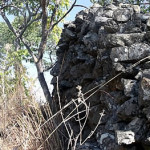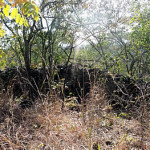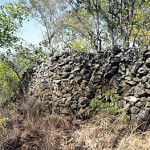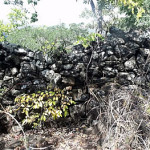Written by Chris Dunbar. All pictures are copyright by Chris Dunbar.
Ruanga, 2012:
Some pictures from Ruanga a settlement that was excavated in the 1960’s and it was found to have been inhabited in the 1500’s to the end of the 1650’s.
Native black africans, but what is interesting is that perhaps, according to Hugh Tracey assumption, Antonio Fernades visited this settlement in May/June of 1514. *1)
It is found in the Umfurudzi Park in Northern Zimbabwe, it has been very much overgrown but we hope one day that it will be cleaned up and preserved.
*1) In 1968 (Hugh Tracey “Antonio Fernades: Rhodesia’s first pioneer” pages 1-26 Rhodesiana n°19 December 1968) the historian Hugh Tracey tried to retrace on paper the routes or routes taken by Antonio Fernades (AF) when he penetrated into the now Zimbabwe Plateau.
We know that he made the two trips, the first trip can be dated pretty accurately as the Second Viceroy of India wrote to the King of Portugal from Goa on the 25th of October 1514 writing about the degredado who was sent to discover the lands of Monomutapa. It would have taken two months for a ship to have gone from Sofala to Goa, so news would have left Sofala perhaps late July 1514. Gasper Veloso the Sofala fort clerk, wrote down the Antonio Fernades account of this journey into the lands of the Monomutapa.
One part of the article discusses Antonio Fernades going to Embire, which is a fortress of the King of Monomutapa which “he is now making of stone without mortar” which is called Camanhaya. It is a journey of five days.
Hugh Tracey argues that this relates to: Antonio Fernades proceeded from Tafuna / Matafuna to the court of Embiri / Mbiri this village of Monomutapa was a fortress called Gamahaya (Kamangaia, or Kwa Manyaia) “which he is now building of stone without mortar”. We know of a few stone fortresses in the district. Fura or Mt Darwin is only two or three days journey from the Mazowe River to Tafuna / Matafuna. On Tungagore between the Mutua and Ruiana Streams is a fortress this is about five days from Tafuna / Matafuna but is fifteen miles east of where the site of Monomutapa’s kraal was believed to be.
Tracey goes on to state “should there prove to be a stone fortress upon the hill Runga (his spelling) it would entirely agree with Antonio Fernades’s five day journey from the Mazowe and place the site of Monomutapa with some accuracy.
The ruins were found on Ruanga (what the locals call it now) and excavated by Garlake, habitation found from the early 1500’s to the mid 1600’s. The other loopholed forts in the area and one is close by are from the refuge period and dated to the late 1600’s. The visit of Antonio Fernades would be dated to about May / June 1514 due to the approximate time it took Antonio Fernades to get back to Sofala and for the ship to leave in July for Goa.
The distance from Tafuna Hill 17 .21.442’S and 31 .30.905’E and Ruanga Ruins 17 .1.307’S and 31 .45.579’E is about 47km’s.
- Ruanga Ruins. Ruanga, Zimbabwe. Photo © by Chris Dunbar
- Ruanga Ruins. Ruanga, Zimbabwe. Photo © by Chris Dunbar
- Ruanga Ruins. Ruanga, Zimbabwe. Photo © by Chris Dunbar
- Ruanga Ruins. Ruanga, Zimbabwe. Photo © by Chris Dunbar
 Colonial Voyage The website dedicated to the Colonial History
Colonial Voyage The website dedicated to the Colonial History







































































